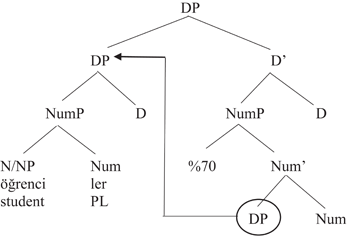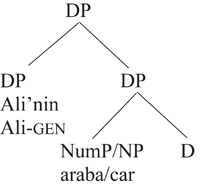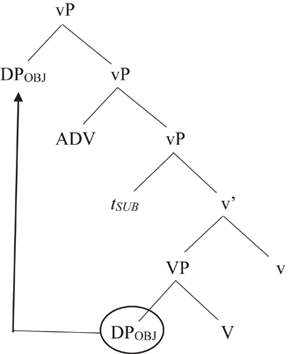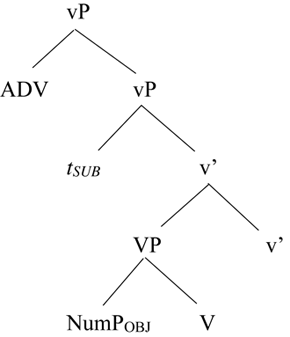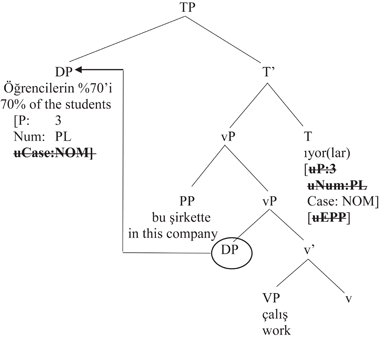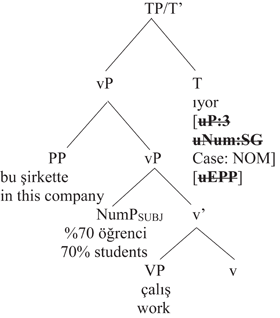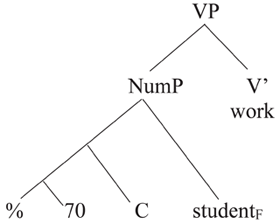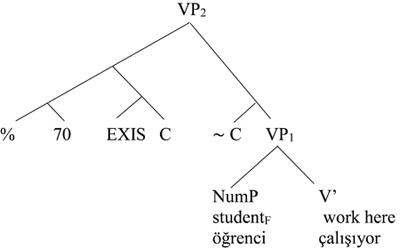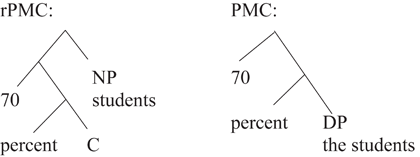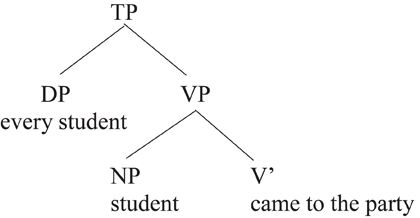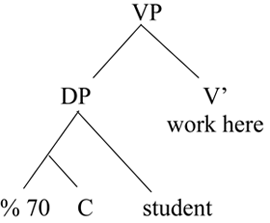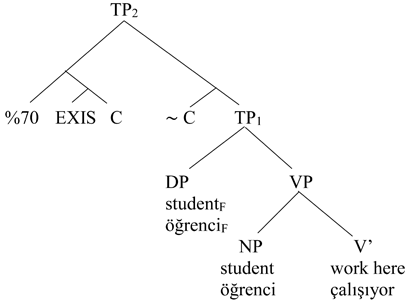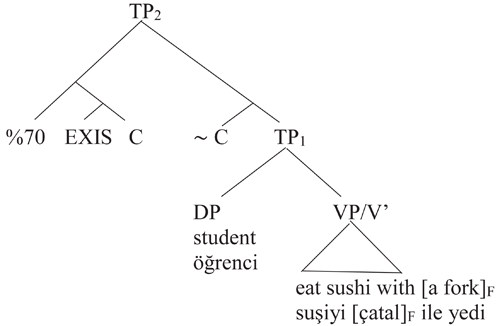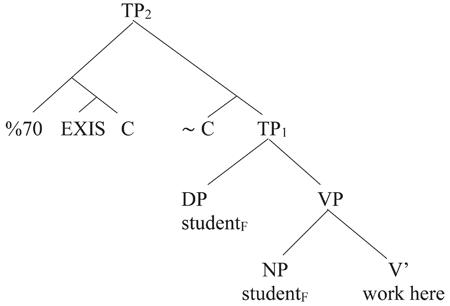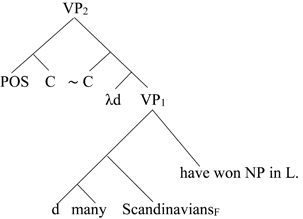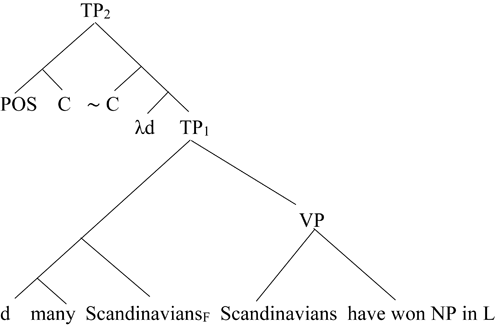1 Introduction
Research on the formal properties of natural language determiners has shown that not every possible determiner is a natural language determiner (Barwise & Cooper 1981). There are certain mathematical properties that each determiner must satisfy. Consider (1):
- (1)
- Most students are anarchists.
Roughly speaking, (1) is true just in case the cardinality of students who are anarchists exceeds the cardinality of students who are not anarchists. To decide whether (1) is true of a group of people, we would first pick out the students in this group and then find out if the number of anarchists exceeds the number of non-anarchists among the students. Crucially, the question of whether there are any anarchist non-students (or non-anarchist non-students) in this group is irrelevant to the truth value of (1).
We could imagine another determiner, call it tsom, which compares the number of anarchist students to anarchist non-students.
- (2)
- Tsom students are anarchists.
- Meaning: ‘Most anarchists are students.’
The absence of tsom in natural languages (and many other determiners that are all too easy to imagine) is accounted for by the Conservativity Constraint (CONS, Barwise & Cooper 1981; Keenan & Stavi 1986), which states that there is no determiner Det such that the truth value of an expression of the form Det P Q is sensitive to the properties of the entities in the complement set of P (i.e. P’). More formally, CONS can be expressed as follows:
- (3)
- Conservativity (definition)
- A determiner Det denotes a conservative function if and only if
- Det(P)(Q) ⇔ Det(P)(P∩Q) for any Pet and Qet.
- CONS: Natural language determiners denote conservative functions.
The truth value of a sentence of the form Tsom P Q is sensitive to the properties of the entitites in the set P’; that is, non-students matter. The determiner tsom, with the denotation given in (4a), does not obey CONS, as can be seen in (4b).
- (4)
- a.
- tsom(P)(Q) ⇔ |P∩Q| > |Q – P|
- b.
- tsom(P)(Q) ⇎ tsom(P)(P∩Q)
- since |P∩Q| > |Q – P| ⇎ |P∩(P∩Q)| > |(P∩Q) – P|
- since |P∩Q| > |Q – P| ⇎ |(P∩Q)| > |∅|
There are some putative counter-examples to CONS (see Zuber & Keenan 2019 for a review). For instance, Westerståhl (1985) notes that, in additional to cardinal (5a) and proportional (5b) readings, the determiner many has a reverse-proportional interpretation (5c), which, Westerståhl suggests, is synonymous with (5d).
- (5)
- a.
- There were many students outside.
- b.
- (There were few students in the exam but…)
- Many (of the few) students did well in the exam
- c.
- Many Scandinavians have won the Nobel prize in literature.
- d.
- Many winners of the Nobel Prize in literature are Scandinavians.
The determiner many denotes a conservative function in its cardinal (6) and proportional (7) interpretations (see Partee 1989 for arguments that many is, indeed, ambigious between the denotations in (6) and (7)). If the reverse proportional reading of many comes from a denotation like (8a), then there are natural language determiners that do not obey CONS.
- (6)
- ⟦manyCARD ⟧(P)(Q) ⇔ |P ∩ Q| > k, k a large number
- (7)
- ⟦manyPROP ⟧(P)(Q) ⇔ |P ∩ Q|/ |P| > k, k a large proportion
- (8)
- a.
- ⟦manyR.PROP⟧(P)(Q) ⇔ |P ∩ Q|/ |Q| > k, k a large proportion
- b.
- ⟦manyR.PROP⟧(P)(Q) ⇎ ⟦manyR.PROP⟧(P)(P ∩ Q)
- since |P ∩ Q|/|Q| > k ⇎ |P ∩ (P ∩ Q)|/|P ∩ Q| > k
Herburger (1997) observes that the determiner few also licenses reverse proportional interpretations. Under one reading, (9) is understood to compare the number of cooks that applied to the totality of applicants, in which case the determiner fewR.PROP, with the denotation in (10), is not conservative.
- (9)
- Few cooks applied
- ‘Few of the applicants were cooks.’
- (10)
- ⟦fewR.PROP⟧(P)(Q) ⇔|P ∩ Q|/ |Q| < k, k a small proportion
Ahn & Sauerland (2015; 2017) have found that there are even more reverse proportional troubles in the paradise of Conservativity. Proportional numerals (eighty percent, one-third etc.) seem to allow for two distinct interpretations: a proportional one and a reverse proportional one.1
- (11)
- a.
- The company hired 75% of the women (proportional)
- ‘75% of the women were hired by the company.’
- b.
- The company hired 75% women. (reverse proportional)
- ‘75% of those hired by the company were women.’
To know whether (11a) is true of a group of people, we would only need information about the recruitment status of the women in this group. As far as the non-women in this group are concerned, whether they are hired or not is irrelevant to the truth value of (11a). This reading can be captured with a conservative denotation for proportional numerals.
- (12)
- ⟦n%PROP ⟧(P)(Q) ⇔ |P ∩ Q|/ |P| = n / 100
To know whether (11b) is true, we would have to know not only how many women are hired but also how many non-women are hired. This non-conservative interpretation can be expressed with the denotation in (13a).
- (13)
- a.
- ⟦n%R.PROP⟧(P)(Q)⇔ |P ∩ Q|/ |Q| = n / 100
- b.
- ⟦n%R.PROP⟧(P)(Q) ⇎ ⟦n%R.PROP⟧(P)(P ∩ Q)
- since |P ∩ Q|/ |Q| = n / 100 ⇎ |P ∩ (P ∩ Q)|/|P ∩ Q| = n / 100
The presence of non-conservative readings of a determiner does not entail that this determiner has a non-conservative denotation. There might be other factors involved in non-conservativity effects associated with a determiner. Herburger (1997), for instance, notes that non-conservative readings of few in (9) arise only when its first argument, or a subpart thereof, is focus-marked, which we indicate with small capitals.
- (14)
- Few cooks applied.
- ‘Few of the applicants were cooks.’
Moreover, when focus is on a subconstituent of the subject we obtain a reading that is not predicted by fewR.PROP. In (15), the cardinality of incompetent cooks is compared not to the totality of applicants (as predicted by fewR.PROP) but to the totality of cooks that applied.
- (15)
- Few incompetent cooks applied.
- ‘Few of the cooks that applied were incompetent cooks.’
Ahn & Sauerland (2015; 2017) note that proportional numerals, too, have such focus-affected readings (in the terminology of Herburger 1997) in their reverse proportional interpretations. In (16), the cardinality of students from Italy is compared not to the cardinality of the workers (as predicted by n%R.PROP) but to the workers who are also students.
- (16)
- German (Ahn & Sauerland 2017: 224)
- 30%
- 30%
- Studenten
- students
- aus
- from
- ItalienF
- Italy
- arbeiten
- work
- hier
- here
- ‘30% of the students that work here are from Italy.’
Following Herburger (1997), Romero (2015) and Ahn & Sauerland (2015; 2017), we suggest that determiners of proportionality (many, few and proportional numerals) have conservative denotations and that the reverse proportional readings of these determiners are a consequence of their interaction with focus. The main contribution of this paper is to show that proportional and reverse-proportional readings of these determiners are correlated with distinct syntactic positions in an LF-tree. Focusing on proportional numerals in Turkish, we claim that
(a) DP-movement of a quantificational element blocks non-conservativity effects due to the NP-copy in the tail of this movement chain (Romoli 2015) and, as a result,
(b) non-conservativity effects associated with determiners of proportionality arise only when the nominal expression modified by these determiners remains in its vP-internal position (Herburger 1997)
In the next section, we shall examine the syntax of proportional and reverse proportional measurement constructions in Turkish and note some key differences between these constructions that play a crucial role in explaining their semantic properties. In Section 3, we discuss how a conservative denotation for proportional numerals can explain their non-conservative interpretions. In Section 4, we develop a movement-theoretic account for the absence of non-conservativity effects with proportional measurement constructions. In Section 5, we extend our analysis to the context-sensitive determiners many and few.
2 The syntax of proportionality in Turkish
In this section, we take a closer look at the syntactic representation of proportional and reverse proportional measurement constructions in Turkish. We focus on the differences between these two constructions in terms of the presence of genitive marking on the noun as well as in the order of the proportional numeral with respect to the noun. These two constructions also differ in the obligatory presence of the accusative marker when they are in the object position as well as in their ability to control verb agreement in the subject position. We shall see in Section 3 and Section 4 that these differences between proportional and reverse proportional measurement constructions in Turkish play a crucial role in explaining their semantic properties.
Proportional numerals in Turkish appear in two different types of constructions with two distinct interpretations.2 The sentence (17), which contains the proportional measument construction öğrencilerin yüzde yetmişi ‘seventy percent of the students’ in the object position, gives us information about the ratio of the students that the company hired to all the students.
- (17)
- Şirket
- company
- öğrenci-ler-in
- student-pl-gen
- yüz-de
- hundred-loc
- yetmiş-in-i
- seventy-poss.acc
- istihdam.et-ti
- hire-pst
- ‘The company hired seventy percent of the students’
In (18), however, we are given information about the ratio of the students that the company hired to all the individuals hired by the company. This interpretation is made available by the presence of the reverse proportional measurement construction yüzde yetmiş öğrenci ‘seventy percent student’ in the object position.
- (18)
- Şirket
- company
- yüz-de
- hundred-loc
- yetmiş
- seventy
- öğrenci
- student
- istihdam.et-ti
- hire-pst
- ‘Seventy percent of those hired by the company were students.’
In this paper, we shall claim that proportional numerals in Turkish form a nominal constituent with the noun they modify. Before we delve into the details of the syntactic representation of these constructions, it is important to rule out an alternative analysis in which a proportional numeral like yüzde yetmiş ‘seventy percent’ is treated as an adverb (For arguments against an adverbial analysis for proportional numerals in other languages, see Ahn & Sauerland 2015 and Ahn & Ko 2022. The claims we make below are in line with these analyses.) As far as proportional expressions like (17) is concerned, the adverbial analysis would imply that the proportional numeral inside (17) is an adverb that is base-generated at the VP-level. Such an analysis can be immediately ruled out for Turkish. Adverbs in Turkish cannot be used in the position that the proportional numeral in (17) is used.
- (19)
- *Şirket
- company
- öğrenci-ler-in
- student-pl-gen
- çoğunlukla-sın-ı/sadece-sin-i
- mostly-poss-acc/only-poss.acc
- istihdam.et-ti
- hire-pst
Arguments against an adverbial analysis for proportional numerals inside reverse-proportional expressions as in (18) need to be more nuanced since replacing the proportional numeral in (18) with an adverb does not lead to unacceptability.
- (20)
- Şirket
- company
- çoğunlukla/sadece
- mostly/only
- öğrenci
- student
- istihdam.et-ti
- hire-pst
- ‘The company hired mostly/only students’
We now show that proportional numerals inside reverse-proportional expressions are not adverbial elements. Let us first observe that the adverbs çoğunlukla ‘mostly’ and sadece ‘only’ do not impose any restrictions on the number and case features of the nominal element in the object position. That is, they can be used both with bare objects as in (20) and with number and case-marked objects as in (21a). This is expected given that these adverbs are merged with the verb phrase and not with the object. However, proportional numerals inside reverse-proportional expressions can only be used with bare objects. This means that, unlike adverbs, proportional numerals are tightly connected to the noun they are associated with (see Ahn & Ko 2022 for a similar argument in the context of reverse-proportional expressions in Korean).
- (21)
- a.
- Şirket
- company
- çoğunlukla/sadece
- mostly/only
- öğrenci-ler-i
- student-pl-acc
- istihdam.et-ti
- hire-pst
- ‘The company hired mostly/only the students’
- b.
- *Şirket
- company
- yüz-de
- hundred-loc
- yetmiş
- seventy
- öğrenci-ler-i
- student-pl-acc
- istihdam.et-ti
- hire-pst
Secondly, adverbs in Turkish can be displaced to the post-verbal domain as in (22a). However, proportional numerals inside reverse-proportional expressions cannot occupy this position (22b). They must immediately precede the noun they modify.
- (22)
- a.
- [Şirket
- company
- t1
- öğrenci
- student
- istihdam.et-ti]
- hire-pst
- çoğunlukla1/sadece1
- mostly/only
- ‘The company hired mostly/only students’
- b.
- *[Şirket
- company
- t1
- öğrenci
- student
- istihdam.et-ti]
- hire-pst
- yüz-de
- hundred-loc
- yetmiş1
- seventy
The discussion above indicates that proportional numerals in Turkish should not be given an adverbial analysis. Rather, they seem to form a nominal constituent with the noun they modify. Given this finding, we can now focus on the internal syntax of proportional and reverse proportional measurement constructions in Turkish. These expressions differ in the presence of number and case marking on the substance noun as well as in the order of the proportional numeral with respect to the noun.
- (23)
- a.
- yüz-de
- hundred-loc
- yetmiş
- seventy
- öğrenci
- student
- (reverse-proportional)
- ‘70% students’
- b.
- öğrenci-ler-in
- student-pl-gen
- yüz-de
- hundred-loc
- yetmiş-i
- seventy-poss
- (proportional)
- ‘70% of the students’
In this section, we shall explicate, and to some extent defend, our assumptions about the internal syntax of (23a) and (23b). Let us start with reverse proportional measurement constructions (rPMCs). Research on nominal syntax of Turkish suggests that the extended projection of a noun includes Number Phrase (NumP, Ketrez 2005; Arslan-Kechriotis 2006; von Heusinger & Kornfilt 2017). Moreover, numerals in Turkish have been argued to be licensed in a specifier position (Arslan-Kechriotis 2006; Sağ-Parvardeh 2019). Under these assumptions, the syntax of (23a) can be represented as in (24) (see von Heusinger & Kornfilt 2017 for similar ideas):
- (24)
Turning now to proportional measurement constructions (PMCs), we see that they differ from rPMCs in the obligatory presence of the plural morpheme and the genitive case marker on the substance noun. The obligatoriness of genitive case suggests that the substance noun is dominated by DP3, which must be case-marked. One piece of evidence for the presence of a DP layer on the substance noun comes from the observation that in a PMC, the substance noun can be used with a demonstrative. In an rPMC, however, the presence of a demonstrative leads to ungrammaticality.
- (25)
- a.
- o
- that
- öğrenci-ler-in
- student-pl-gen
- yüz-de
- hundred-loc
- yetmiş-i
- seventy-poss
- ‘seventy percent of those students’
- b.
- *yüz-de
- ‘hundred-loc
- yetmiş
- seventy
- o
- that
- öğrenci(-ler)
- student(-pl)
Finally, word order in PMCs can be explained on the assumption that there is DP-internal DP movement in Turkish (Öztürk & Taylan 2016) The structure of (23b), under these assumptions, is shown in (26).
- (26)
Under this analysis of PMCs in Turkish, the genitive-marked DP starts out as an argument of the Num head and moves to Spec DP, which is the position where DP is assigned genitive case. We might, of course, imagine an alternative analysis in which the genitive DP is base-generated at Spec DP. In what follows, we shall provide some syntactic evidence suggesting that the genitive DP, indeed, starts out as a lower argument in the tree.
Genitive-marked DPs can be used both with relational nouns and with non-relational nouns and this distinction plays a role in the acceptability of a genitive DP in the predicate position (Partee 1997).
- (27)
- a.
- John’s brother (relational)
- b.
- #That brother is John’s.
- (28)
- a.
- John’s team (non-relational)
- b.
- That team is John’s.
Partee & Borschev (2003) argue that there is a distinction to be made between modificational genitives and argumental genitives. The syntactic correlate of this distinction in Russian is the order between the genitive DP and its associate. In (29a), where the genitive DP follows its associate, we obtain the argumental interpretation, in which Petja is the victim of a murdering event. Prenominal possessive DPs do not license this interpretation.
- (29)
- Russian (Partee & Borschev 2003)
- b.
- ubijica
- murderer.m.sg
- Peti
- Petja.gen.sg
- (argument)
- ‘murderer of Petja’
- b.
- Petin
- Petja.poss.m.sg
- ubijica
- murderer.m.sg
- (modifier)
- #’murderer of Petja’ [ok as a murderer Petja hired.]
Öztürk & Taylan (2016) observe that in Turkish the syntactic correlate of argument-modifier distinction for genitives is the presence or the absence of the possessive suffix (POSS) on the associate noun. In some constructions, this suffix appears to be optional:
- (30)
- Ali-nin araba-(sı)
- Ali-gen car-poss
- ‘Ali’s car’ (the car that Ali owns/likes/chose etc.)
However, the victim-murderer relation that we find in (29a) can only be expressed if the genitive constuction contains the POSS suffix on the associate noun. In the absence of the POSS suffix (‘naked genitives’), this reading is not available.
- (31)
- a.
- kadın-ın
- woman-gen
- katil-i
- murderer-poss
- ‘the murderer of the woman’
- b.
- kadın-ın
- woman-gen
- katil
- murderer
- # ‘The murderer of the woman’
- ‘the murderer the woman hired/chose/liked etc.’
Öztürk & Taylan observe that inherently relational nouns (kinship terms, verb-related nouns and nouns that denote various types of part-whole relations) are unacceptable in naked genitive constructions.
- (32)
- a.
- öğretmen-in
- teacher-gen
- hala*(-sı)
- aunt-poss
- b.
- bina-nın
- building-gen
- yıkım*(-ı)
- demolition-poss
- c.
- masa-nın
- table-gen
- kenar*(-ı)
- edge-poss
Under their analysis, the absence of the POSS suffix implies that the genitive-marked DP does not participate in DP-internal DP movement. Rather, it is directly merged at DP as an adjunct. ((33) is the representation of (30) in the absence of the POSS suffix).
- (33)
Inherently relational nouns, however, require the presence of a syntactically represented argument in a lower position, which then moves to the specifier of DP presumably for case reasons.
Going back to PMCs in Turkish, we observe that the POSS suffix is obligatory in these constructions.
- (34)
- *öğrenci-ler-in
- student-pl-gen
- yüz-de
- hundred-loc
- yetmiş
- seventy
- ‘70% of the students’
This observation provides independent evidence for the lower position of the genitive DP in the analysis of PMCs. The genitive-marked DP starts out as the syntactic sister of Num and moves to Spec DP as we have shown in (26).4
Another difference between PMCs and rPMCs in Turkish is the obligatoriness of case-marking. When used in the object position, PMCs must be in the accusative case. rPMCs, on the other hand, need not be case-marked. In fact, the presence of the accusative case marker on an rPMC is highly marked, if not unacceptable.5
- (35)
- a.
- Şirket
- company
- kadın-lar-ın
- woman-pl-gen
- yüzde
- hundred-loc
- yetmiş-in*(-i)
- seventy-poss-acc
- işe
- job.dat
- aldı
- take.pst
- ‘The company hired 70% of the women.’
- b.
- Şirket
- company
- (işe)
- job.dat
- yüz-de
- hundred-loc
- yetmiş
- seventy
- kadın(*/??-ı)
- woman-acc
- aldı
- take.pst
- ‘The company hired 70% women.’
Unlike non-case-marked objects, which remain in their VP-internal position, case-marked objects in Turkish undergo DP-movement (Zidani-Eroğlu 1997; Aygen-Tosun 1999; Arslan-Kechriotis 2006; see Diesing 1992 and Kelepir 2001 for a discussion of LF-consequences of this movement). One piece of evidence for this claim comes from the position of low adverbs with respect to different types of objects. Case-marked objects must precede low adverbs while non-case-marked objects must follow them.
- (36)
- a.
- Ali (*güzel)
- Ali beautiful.adv
- şarkıyı
- song-acc
- güzel
- beautiful.adv
- söyledi
- say.pst
- ‘Ali sang the song beautifully’
- b.
- Ali
- Ali
- güzel
- beautiful.adv
- şarkı
- song
- (*güzel)
- beautiful.adv
- söyledi
- say.pst
- ‘Ali sang (a song) beautifully.’
PMCs in the object position are similar to other case-marked objects in that they must precede low adverbs.
- (37)
- Ahmet (*tamamen)
- Ahmet completely
- kitap-lar-ın
- book-pl-gen
- yüz-de
- hundred-loc
- yetmiş-in-i
- seventy-poss-acc
- tamamen
- completely
- okudu.
- read
- ‘Ahmet read seventy percent of the books completely.’
As expected, rPMCs in the object position must immediately precede the verb.
- (38)
- Şirket
- company
- hemen
- immediately
- (işe)
- job.dat
- yüz-de
- hundred-loc
- yetmiş
- seventy
- kadın
- woman
- (*hemen)
- immediately
- aldı.
- take.pst
- ‘The company hired seventy percent women immediately.’
We shall assume that ACC-marked objects in Turkish move to the specifier of vP (Kelepir 2001; Arslan-Kechriotis 2006), which is how they precede vP-level adverbs.
- (39)
rPMCs, on the other hand, remain in their VP-internal position.
- (40)
PMCs and rPMCs in Turkish also differ in their ability to control subject agreement. In Turkish, finite verbs agree with the subject in number and person. For third person plural DP-subjects, agreement with the finite verb is optional:
- (41)
- Çocuk-lar
- child-pl
- çok
- a.lot
- çalış-tı(-lar)
- work-pst-3pl
- ‘The children worked hard.’
Similar to simple DP subjects, PMCs also participate in (optional) plural agreement with the verb.
- (42)
- Öğrenci-ler-in
- student-pl-gen
- yüz-de
- hundred-loc
- yetmiş-i
- seventy-poss
- bu
- this
- şirket-te
- company-loc
- çalış-ıyor(-lar)
- work-impf-3pl
- ‘Seventy percent of the students work in this company.’
In the context of an rPMC in the subject position, however, plural agreement is not possible.
- (43)
- Bu
- this
- şirket-te
- company-loc
- yüz-de
- hundred-loc
- yetmiş
- seventy
- öğrenci
- student
- çalış-ıyor(*-lar)
- work-impf-3pl
- ‘In this company, seventy percent of the workers are students.’
Note that (42) and (43) also differ in the relative position of the subject with respect to the adjunct PP. Similar to rPMCs in the object position, rPMCs in the subject position must remain adjacent to the verb. Forcing movement of a rPMC to the canonical subject position leads to a sentence that is highly marked (possibly unacceptable).
- (44)
- */??Yüz-de
- hundred-loc
- yetmiş
- seventy
- öğrenci
- student
- bu
- this
- şirket-te
- company-loc
- çalış-yor
- work-impf
These observations about proportional numerals in the subject position can be explained within the AGREE framework of Chomsky (2000; 2001; see Cagri 2005 and Arslan-Kechriotis 2006 for discussion). The T head in Turkish acts as a probe by virtue of having unvalued person and number features in addition to a valued case feature. The T head finds the subject DP in its search domain which has valued instances of the number and person features (as well as an unvalued case feature which makes the goal DP active to participate in AGREE). Since the conditions for the application of AGREE between the T probe and the DP goal are met, the unvalued features on these elements are valued and deleted. Finally, the EPP feature on the T head is satisfied by the movement of the goal DP to the specifier of TP (see Cagri 2005 for a detailed discussion of EPP in Turkish). The syntactic representation of (42) is shown in (45).
- (45)
The optional presence of the plural agreement in the context of a PMC in the subject position can be expressed with the help of the optional rule in (46):
- (46)
- [3, PL] → lAr (optional)
An rPMC in the subject position lacks the D layer. This means that the T head cannot find a DP that contains valued instances of its unvalued features. In this case, the uninterpretable features on the T head get the default value (which is third person singular in Turkish, see Kornfilt 2007 and Satik 2020 for a recent discussion of default agreement in Turkish). We assume, moreover, that EPP in Turkish can only be satisfied by a DP (and that in the absence of an accessible DP in the structure, EPP is deleted by default). Therefore, rPMCs remain in their base position inside vP, which accounts for their position with respect to the PP adjuncts. The syntactic representation of (43) is as in (47):
- (47)
This concludes our discussion of the syntactic analysis of constructions involving proportional numerals in Turkish. In the next section, we shall take a closer look at how the form of rPMCs is related to their semantic properties. We show that the analysis proposed in Ahn & Sauerland (2015; 2017) can be adjusted to account for non-conservative readings of rPMCs in Turkish.
3 An account of non-conservativity effects in Turkish
In this section, we focus on the semantic analysis of reverse proportional measurement constructions (rPMCs) in Turkish. Adopting largely the analysis by Ahn & Sauerland (2015; 2017), we show that non-conservative readings associated with rPMCs can be accounted for in a way that is compatible with the Conservativity Constraint once the interaction between proportional numerals and focus is taken into consideration. As we have seen in Section 2, proportional measurement constructions (PMCs) differ from rPMCs in the obligatory presence of the accusative case marking in the object position, which, we have argued, is indicative of DP-movement. In Section 4, we shall show that the unavailability of non-conservative readings in the context of PMCs is a semantic consequence of the lower copy that is left behind by the relevant DP movement in the tail of the movement chain (Romoli 2015). Finally, in Section 5, we claim that the analysis we have provided for the distinction between rPMCs and PMCs explains the distribution of conservative and non-conservative interpretations of context-sensitive proportional determiners few and many.
In this section, our focus is the semantic analysis of rPMCs in Turkish, an example of which is given below.
- (48)
- (Bu şirkette)
- (This company-loc)
- yüz-de
- hundred-loc
- 70
- 70
- öğrenci
- student
- çalışıyor
- work.impf
- ‘%70 of the workers (in this company) are students’
(48) is true just in case the student workers constitute seventy percent of all the workers in the company. In other words, the ratio of the student workers to the non-student workers is claimed to 7 to 3. Let us pretend, for the moment, that the truth conditions of (48) is obtained as a result of the denotation of yüzde 70 ‘seventy percent’ given in (49).
- (49)
- ⟦yüzde 70⟧(P)(Q) ⇔ |P ∩ Q|/ |Q| = 70 / 100
What is striking about the entry in (49) is that it makes the determiner yüzde 70 ‘70 percent’ a counterexample to a semantic generalization over determiner denotations known as the Conservativity Constraint (CONS, Barwise & Cooper 1981; Keenan & Stavi 1986 a.o.), defined below (repeated from (3)):
- (50)
- Conservativity (definition)
- A determiner Det denotes a conservative function if and only if
- Det(P)(Q) ⇔ Det(P)(P∩Q) for any Pet and Qet.
- CONS: NL-determiners denote conservative functions.
The denotation assigned to yüzde 70 ‘seventy percent’ in (49) is not a conservative function given that the equivalence in (51) does not hold.
- (51)
- ⟦70 %⟧(P)(Q) ⇎ ⟦70⟧(P)(P ∩ Q)
- since |P ∩ Q|/|Q| = 70 / 100 ⇎ |P ∩ (P ∩ Q)|/|P ∩ Q| = 70 / 100
Intuitively, CONS implies that the truth value of an expression of the form Det P Q is only affected by the properties of the entities in the set P. That is to say, the properties of the entities that are not in the extension of P do not play any role in establishing the truth value of Det P Q. If yüzde 70 ‘70 percent’ were a conservative determiner, then the properties of non-students would play no role in establishing the truth conditions of the sentence in (48). This is not what we find, however. The truth value of (48) depends crucially on the cardinality of workers who are not students. Consider a company with 70 student workers. The sentence (48) is true if this company has 30 non-student workers and false otherwise. The recruitment status of non-students is crucial in establishing the truth value of this sentence.
The fact that (48) has a non-conservative reading does not entail that the determiner yüzde 70 ‘70 percent’ has a non-conservative denotation as in (49). We shall see that non-conservativity effects associated with this determiner arise due to factors other than its denotation. Let us first note that in languages as diverse as German (see 52), Georgian, Korean and Mandarin, the substance noun, or a subpart thereof, must be focus-marked for non-conservative readings to be available (see Ahn & Sauerland 2017 for discussion). We indicate focus-marked constituents with the subscript F and the syllable stressed due to the focus feature is capitalized.
- (52)
- German (Ahn & Sauerland 2017: 219)
- 30 Prozent
- 30 percent.nom
- [StuDIERende]F
- students.nom
- arbeiten hier
- work here
- ‘30 percent of workers here are students.’
In (48), too, there is a pitch accent on öğrenci ‘student’, which we interpret as the presence of a focus feature on the substance noun. That is to say, Turkish is no exception to the generalization that non-conservative readings associated with a proportional determiner are parasitic on the presence of a focus feature inside the first argument of the proportional determiner. Moreover, similar to what Ahn & Sauerland (2017) report for German, the interpretation of a Turkish sentence with an rPMC is affected by the exact placement of focus inside the noun phrase. The sentence (53a), in which the focus feature is on the entire noun phrase Türk öğrenci ‘Turkish student’, gives us information about the percentage of the Turkish students among all the workers. A sentence like (53b), on the other hand, with focus on Türk ‘Turkish’, is understood to compare the number of the student workers from Turkey to the number of all the student workers in the company and not to the number of all the workers (students or otherwise) in the company.
- (53)
- a.
- Bu
- this
- şirket-te
- company-loc
- yüz-de
- hundred-loc
- 70
- 70
- [Türk
- Turkish
- öğrenci]F
- student
- çalışıyor.
- work.impf
- ‘%70 of the workers in the company are students from Turkey.’
- b.
- Bu
- this
- şirket-te
- company-loc
- yüz-de
- hundred-loc
- 70
- 70
- [türk]F
- Turkish
- öğrenci
- student
- çalışıyor
- work.impf
- ‘%70 of the student workers in the company are from Turkey.
The denotation we have assumed for the determiner yüzde 70 ‘sevent percent’ in (49) might account for the interpretation of the sentence in (53a) but it does not reflect the truth conditions of (53b) accurately. There may be many workers in the company who are not students but so long as %70 of the student workers are from Turkey, the sentence in (53b) is judged to be true. An adequate semantic analysis of (53b) must reflect the fact that the truth conditions of sentences involving rPMCs are affected by the placement of the focus feature.
In order to model focus-sensitivity of rPMCs, we follow Ahn & Sauerland (2015; 2017) in adopting the alternative semantics framework of Rooth (1992). In Rooth’s framework, each LF-node is associated with a focus semantic value in addition to its regular semantic value. That is, the overall interpretation of a sentence involving a focus-sensitive operator is determined by two dimensions of meaning associated with LF-nodes: a regular denotation and a focus denotation. Let α be a focus-marked LF-node of type δ, where the focus feature on α is indicated as αF. The focus semantic value of α, i.e. ⟦ αF ⟧f, is a contextually-determined subset of the set of entities of type δ. As an example, consider the adjective Turkish (of type <e,t>) with the regular denotation given in (54a). If this adjective is focus-marked then its focus semantic value is a subset of the set of entities of type <e,t>, i.e. a subset of D<et>, as in (54b). Contextual restrictions determine which subset of the domain of entities of type <e,t>, i.e. which subset of D<et>, is chosen to be the focus value of TurkishF.
- (54)
- a.
- ⟦ TurkishF ⟧ = λx.x is Turkish
- b.
- ⟦ TurkishF ⟧f= {λx.x is Turkish, λx.x is Russian, λx.x is German …}
The focus semantic value of a node β that is not focus-marked is the singleton containing the denotation of β.
- (55)
- a.
- ⟦ student ⟧ = λx.x is a student
- b.
- ⟦ student ⟧f = {λx.x is a student}
Since both the adjective Turkish and the common noun student are type <et>, the regular denotation of their merger is obtained by applying the rule of Predicate Modification6 (Heim & Kratzer 1998: 65 among others):
- (56)
- ⟦ TurkishF student ⟧ = λx.x is Turkish and x is a student
The focus denotation of this merger is obtained via the pointwise application of the rule of Predicate Modification:
- (57)
- Pointwise Predicate Modification
- If
- Then
- φ has two daughters, α and β, of type <e,t>
- ⟦ φ ⟧f = {λx. g(x) ∧ h(x): g ∈ ⟦α ⟧f, h ∈ ⟦β ⟧f}
The rule of Pointwise Predicate Modification is applied to the pairs of denotations in the focus value of TurkishF and student. The focus value of the phrase TurkishF student is then the set of denotations given in (58):
- (58)
- ⟦ TurkishF student ⟧f = {λx.x is Turkish and x is a student,
- λx.x is Russian and x is a student,
- λx.x is German and x is a student …}
Assuming that some is an existential determiner with the denotation in (59a), we find that the regular denotation of the merger of some with TurkishF student is as in (59b). The focus semantic value of this merger is the set of denotations obtained by applying the members of focus value of TurkishF students to the only member of the focus value of the determiner some. Given the set in (58), this procedure, known as Pointwise Functional Application,7 gives us the result shown in (59c).
- (59)
- a.
- ⟦ some⟧ = λP. λQ. ∃x: P(x) ∧ Q(x)
- b.
- ⟦ some TurkishF student⟧ = λQ. ∃x:Turkish(x) ∧ student(x) ∧ Q(x)
- c.
- ⟦ some TurkishF student⟧f = {λQ. ∃x:Turkish(x) ∧ student(x) ∧ Q(x),
- λQ. ∃x:Russian(x) ∧ student(x) ∧ Q(x),
- λQ. ∃x:German(x) ∧ student(x) ∧ Q(x) … }
We are now ready to explicate our assumptions about the semantic analysis of rPMCs in Turkish. The sensitivity of proportional numerals to the placement of the focus feature in an LF-tree is modelled with the help of a free variable C, whose value, as we shall see, is constrained by the focus denotation of LF-nodes. The first argument of a proportional numeral in an rPMC is this variable C.
- (60)
A node with the squiggle operator, ∼C, is adjoned to VP, whose function to restrict the variable C by the focus value of its sister VP. The adjunction of ∼C to VP is followed by the movement of constituent containing the proportional numeral and C (see Ahn & Sauerland 2017 for discussion. We discuss EXIS below) so that C is properly restricted by focus in (61).
- (61)
The regular denotation of VP1 is obtained via the application of Predicate Modification to the denotation of NumP and V’.8 The focus semantic value of VP1 in (62d) is the result of applying the rule of Pointwise Predicate Modification to the focus value of V’ in (62b) and NumP in (62c).
- (62)
- a.
- ⟦ VP1 ⟧ = λx. x is a student and x works here
- b.
- ⟦ V’ ⟧f = {λx. x works here}
- c.
- ⟦ NumP ⟧f = {λx. x is a student, λx. x is a teacher, λx. x works here…}
- d.
- ⟦ VP1 ⟧f = {λx. x is a student and x works here,
- λx. x is a teacher and x works here,
- λx. x works here and x works here ≈ λx. x works here…}
Since both the predicate student and the predicate works here are of the same type, λx. x works here is a member of the focus value of studentF. Therefore, the predicate denoted by V’ is a member of the focus value of VP1. Moreover, the set characterized by ⟦V’⟧ is a superset of any set characterized by any member of ⟦VP1⟧f, a result that will prove to be significant later on.
The denotation of a consituent obtained by adjoining ∼ C to a phrase α, i.e. [β ∼ C α], is the same as the denotation of α. However, the focus semantic value of α plays a crucial role in determining the members of the set C. We shall assume that the set C is identical to the set of focus alternatives of α. As far as (61) is concerned, this means that C is the equivalent to ⟦VP1⟧f.
- (63)
- Given a structure [β ∼ C α], ⟦ β ⟧ is defined only if C = ⟦ α ⟧f.
- If defined, ⟦ α ⟧ = ⟦ β ⟧
We suggest that yüzde ‘percent’ in Turkish is a parametrized determiner (see Hackl, 2000 and Romero 2015 for a parametrized determiner analysis of many, as we discuss in Section 5).
- (64)
- ⟦ yüzde ⟧ = ⟦ % ⟧ = λn.λP.λQ.|P ∩ Q | / |P| = n / 100
The result of combining a numeral n and yüzde ‘percent’ is a proportional determiner, a function from properties to sets of properties (i.e. to generalized quantifiers).
- (65)
- ⟦ 70% ⟧ = λP.λQ.|P∩Q| / |P| = 70 / 100
Such a determiner is conservative, as can be seen from the equivalence in (66).
- (66)
- ⟦ 70% ⟧(P)(Q) ⇔ ⟦ 70% ⟧(P)(P∩Q)
- since |P∩Q| / |P| = 70 / 100 ⇔ |P∩(P∩Q)| / |P| = 70 / 100
In fact, more generally, we can say that any determiner of the form n% is conservative.
- (67)
- ⟦ n% ⟧(P)(Q) ⇔ ⟦ n% ⟧(P)(P∩Q)
- since |P∩Q| / |P| = n / 100 ⇔ |P∩(P∩Q)| / |P| = n / 100
Going back to the interpretation of (61), we realize that the free variable C is not of appropriate type to be an argument for the determiner % 70. We need to map the free varible C into a predicate, which is what EXIS does. EXIS takes a set of predicates and returns a predicate which is true of an entity just in case there is a member of C that is true of this entity.9 Formally,
- (68)
- EXIS(C) = λx.∃f ∈ C such that f(x) = 1
We have noted earlier that ⟦ V’ ⟧ ∈ C. Observe that for all f ∈ C and for all x, f(x) →⟦ V’⟧(x). From this, it follows that EXIS(C) = λx. ⟦ V’⟧(x), which is to say, EXIS(C) = ⟦ V’ ⟧ = λx. x works here. Given these observations, the truth conditions of (61) are as follows (S = the set of students and W = the set of workers):
- (69)
- ⟦ 70 % ⟧(EXIS(C))(S∩W) ⇔ |EXIS(C)∩(S∩W)|/|EXIS(C)|=70/100
- ⇔ |W∩(S∩W)|/|W|=70/100
- ⇔ |S∩W|/|W|=70/100
This is the reverse proportional interpretation that arises in the context of rPMCs. As expected, we are comparing the cardinality of student workers to all workers. It should be noted that, for any n, the determiner yüzde n ‘n percent’ is a conservative determiner. Crucially, we need not postulate a determiner with a non-conservative denotation in order to account for the non-conservativity effects associated with proportional numerals.
At this point, a question arises as to why proportional measurement constructions (PMCs) do not give rise to non-conservative readings in the way that rPMCs do. In Section 2, we have shown that, unlike rPMCs, PMCs undergo obligatory DP-movement, which is evidenced by the obligatory presence of the accusative marker when they are used in the object position. In the next section, we show that it is this movement operation that makes it impossible for PMCs to have non-conservative readings (Romoli 2015).
4 DP-movement blocks non-conservativity effects
In Section 3, we have seen that non-conservative readings of reverse proportional measurement constructions (rPMCs) can be analyzed as arising from the interaction of focus with a conservative denotation for proportional numerals. We now take a look at the absence of non-conservative readings for proportional measurement constructions (PMCs) in Turkish. In Section 2, we have shown that, unlike rPMCs, PMCs undergo obligatory DP-movement (presumably for case reasons). Following Fox (2002), Sportiche (2005) and Romoli (2015), we suggest that the NP-copy that is left behind in the tail of this movement chain makes non-conservative readings impossible. In Section 5, we shall show that our analysis for the absence of non-conservative readings for PMCs also provides a natural account for why context-sensitive proportional determiners few and many lack reverse-proportional readings when they are used with individual-level predicates.
Ahn & Sauerland (2017) suggest that the absence of non-conservativity effects in the context of PMCs can be understood to be a consequence of syntactic differences between rPMCs and PMCs.10 In an rPMC the first argument of percent is the contextual variable C, which accounts for focus-sensitivity of such constructions. In a PMC, however, the first argument is the substance noun itself.
- (70)
Under such an analysis, focus does not play any role in the interpretation of PMCs. There is, however, reason to believe that the placement of the focus feature has truth conditional consequences for sentences containing PMCs. Consider (71a) and (71b), which minimally differ in the constituents that are focused.
- (71)
- a.
- Öğrenci-ler-in
- student-pl-gen
- yüz-de
- hundred-loc
- yetmiş-i
- seventy-poss
- suşi-yi
- sushi-acc
- çatal
- fork
- ile
- with
- yedi.
- eat.pst
- ‘70% of the students who ate sushi ate it with a fork.’
- b.
- Öğrenci-ler-in
- student-pl-gen
- yüz-de
- hundred-loc
- yetmiş-i
- seventy-poss
- suşi-yi
- sushi-acc
- çatal
- fork
- ile
- with
- yedi.
- eat.pst
- ‘70% of the students who ate something with a fork ate sushi with a fork.’
In (71a), we are interested in the proportion of the students who ate sushi with a fork to the students who ate sushi. In (71b), we are interested in the proportion of the students who ate sushi with a fork to the students who used a fork to eat something (sushi, pasta, cake etc). An analysis of PMCs must reflect focus-sensitivity of these constructions.
Note also that partitive syntax might be a sufficent condition to block non-conservativity effects but it is not, strictly speaking, necessary. Westerståhl (1985) notes that, unlike (72a), (72b) cannot have the non-conservative interpretation associated with many.
- (72)
- a.
- Many Scandinavians have won the Nobel prize in literature.
- b.
- Many Scandinavians are Nobel prize winners in literature.
Similarly, Herburger (1997) observes that reverse-proportional interpretations of the determiner few is possible with stage-level predicates but not with individual-level predicates.
- (73)
- a.
- Few cooks applied. (stage-level)
- ‘Few of the applicants are cooks’
- ‘Few of the cooks applied.’
- b.
- Few cooks know how to make a soufflé. (individual-level)
- #‘Few of those who know how to make a soufflé are cooks.’
- ‘Few of the cooks know how to make a soufflé.’
The presence of an individual-level predicate seems to be sufficent to block non-conservativity effects.11
We have noted earlier that one syntactic difference between rPMCs and PMCs in Turkish is that PMCs undergo syntactic movement operation, which accounts for the position of PMCs with respect to vP-level adverbs.
- (74)
- Ahmet
- Ahmet
- (*tamamen)
- completely
- kitap-lar-ın
- book-pl-gen
- yüz-de
- hundred-loc
- yetmiş-in-i
- seventy-poss-acc
- tamamen
- completely
- okudu.
- read
- ‘Ahmet read seventy percent of the books completely.’
When a quantificational DP undergoes movement, the tail of the movement chain is usually assumed to be a trace. An alternative approach, inspired by the Copy Theory of movement (Chomsky 1995), suggests that the tail of a movement chain contains not a trace but a copy of the moved element or a subpart thereof. More specifically, it has been suggested that the NP part of the moved element is interpreted both in the tail and the head of the movement chain (Sauerland 1998; Fox 2002 and Sportiche 2005). Following Romoli (2015), we assume that the movement of a quantificational DP leaves the NP portion of the DP in the tail of the movement chain.12 Under these assumptions, the syntactic representation of (75) is as in (76):
- (75)
- Every student came to the party
- (76)
Fox (2002) and Sportiche (2005) suggest that the presence of an NP-copy in the tail of a movement chain might provide an account of why natural language determiners are conservative. The idea is that the interpretation of a non-conservative determiner in a tree like (76) would always lead to a contradictory or tautological (i.e. trivial) meaning due to the NP-copy in the tail of the chain (see Gajewski 2002 on the types of trivialities that are ungrammatical). Consider the hypothetical determiners every’ and every’’, both of which are non-conservative.
- (77)
- a.
- every’(P)(Q) ⇔ P ⊂ Q (non-conservative)
- b.
- every’’(P)(Q) ⇔ Q ⊆ P (non-conservative, only)
Replacing the determiner every in (76) with every’ or every’’, we obtain the truth conditions in (78):
- (78)
- a.
- every’(S)(S ∩ C) ⇔ S ⊂ S ∩ C (Contradiction)
- b.
- every’’(S)(S ∩ C) ⇔ S ∩ C ⊆ C (Tautology)
Assuming that semantic grammar does not tolerate trivialities of this sort (Gajewski 2002), we could explain the absence of every’ and every’’ in natural languages (see Romoli 2015 for a nuanced view of what ‘triviality’ for NL-determiners means).
We claim that the absence of non-conservativity effects in PMCs can be accounted for under similar assumptions. More precisely, we assume that DP movement in Turkish leaves a subconstituent, i.e. NP, in the tail of the movement chain. As far as DP movement inside a PMC is concerned, we assume that the NP-copy in the tail of this movement chain is all that is relevant for interpretation. The semantically-relevant aspects of a PMC inside a VP can be represented as in (79):
- (79)
DP in (79) moves to Spec TP, leaving an NP-copy in the tail of the chain:
- (80)
Similar to what we have seen in rPMCs, the node containing ∼C is adjoined to TP, which is followed by the movement of the consitutent containing C.
- (81)
Let us consider the interpretation of (81).13
- (82)
- a.
- ⟦VP⟧ = λx. x is a student and x works here
- b.
- ⟦TP1⟧ = λx. x is a student and x works here
- c.
- ⟦TP1⟧f = {λx. x is a dentist and x is a student and x works here,
- λx. x is a student and x is a student and x works here,
- λx. x is works here and x is a student and x works here
- …}
Observe that the set characterized by λx. x is a student and x works here is a superset of every member of ⟦TP1⟧f. Therefore, EXIS(C) = ⟦TP1⟧. We have:
- (83)
- ⟦%70⟧(EXIS(C))(⟦TP1⟧) ⇔ ⟦%70⟧(S∩W)(S∩W) (Contradiction)
For any n, 0 < n < 100, replacing 70 in (81) with n results in contradiction.14 This means that in the context of an PMC in the subject position, the focus feature cannot be inside the subject. That is, the focus feature must be contained inside V’.
Let us show that the analysis we have for PMCs can account for the focus-sensitivity of such consturctions ((71a) and (71b)). Observe that, given the assumptions we have made, the tree representation of (71a) is as in (84):
- (84)
- (85)
- C = ⟦TP1⟧f = { λx. x is a student and x ate sushi with a fork,
- λx. x is a student and x ate sushi with chopsticks
- λx. x is a student and x ate sushi with a spoon, … }
We assume the equivalence in (86) holds:
- (86)
- EXIS(C) = λx. x is a student and x ate sushi somehow
- λx. x is a student and x ate sushi somehow ≈ λx. x is a student and x ate sushi
- EXIS(C) = λx. x is a student and x ate sushi
The overall interpretation for (84) is shown in (87), where S is the set of students, Su is the set of sushi-eaters, F is the set of fork-users (For brevity, we shall assume that the denotation of eat sushi with a fork is the instersection of Su and F, i.e. Su∩F):
- (87)
- ⟦%70⟧(EXIS(C))(⟦TP1⟧) ⇔ ⟦%70⟧(S∩Su)(S∩Su∩F)
- ⇔ |S∩Su∩F| / |S∩Su| = 70/100
This interpretation captures the intuitions reported in (71a) accurately.
Before closing this section, we must mention an issue about the placement of focus inside a PMC in the subject position. In (81), we have assumed that the tail of a movement chain cannot be focus-marked. This is a crucial assumption for the sentence to be trivial. To see why, consider a variant of (81) in which there is also a focus feature on the noun dominated by VP as in (88):
- (88)
Replacing each focus marked constituent in (88) with λx. x works, we find that λx. x works ∈ C. That is, EXIS(C) = λx. x works here. Therefore, ⟦ (88) ⟧ ⇔ |S∩W|/|W|=70/100. This corresponds to the reverse-proportional reading that PMCs are supposed to lack. We have to find a way to block a representation like (88).
Beaver & Clark (2008) claim that the tail of a movement chain (in their analysis, a trace) cannot be focus-marked. This requirement, they argue, provides an explanation for the fact that the focus-sensitive operator only cannot associate with a focus-marked XP that is moved from its c-command domain (see Beaver & Clark 2008: 165 for the examples below)
- (89)
- a.
- Fishsticks, I believe Kim only buys. (Topicalization)
- *‘I believe that Kim buys fishsticks and nothing else.’
- b.
- On Sunday, I thought you only went to the store (Adverb Preposing)
- *‘I thought that you only went to the store on Sunday and no other day.’
- c.
- Guinness is what I think Kim only wants to drink. (Inverted wh-cleft)
- *‘I think Kim wants to drink Guinness and nothing else.’
Interestingly, this behavior of only is not shared by the focus-sensitive operator even (Erlewine 2014a,b, see also Tancredi 1990 and Kayne 1998 for similar observations).
- (90)
- a.
- MaryF, John even met at the party.
- b.
- *MaryF, John only met at the party.
Moreover, even can associate with the subject preceding it but only cannot.
- (91)
- a.
- A professorF is even at the party.
- b.
- *A professorF is only at the party
Erlewine argues that a successful account of why (90a) and (91a) are grammatical relies on the presence of an F-marked constituent in the tail of the movement chains as in:
- (92)
- a.
- [MaryF [John even [met MaryF at the party]]]
- b.
- [A professorF [is even [VP [a professorF] at the party]]]
For Erlewine, the unacceptability of (90b) and (91b) is related to the fact that only and even differ in what they do with the set of alternatives. The operator only presupposes its prejacent and asserts the negation of (non-weaker) alternatives, as a result of which sentences like (90b) and (91b) lead to presupposition failure.15 The operator even, on the other hand, does not affect truth conditions of a sentence but only projects a scalar inference (in (90a), the relevant inference would be that Mary is a relatively unlikely person for John to meet at the party).
All in all, the assumption that the tail of a movement chain cannot be focus-marked is not uncontroversial. Let us pretend, for the sake of argument, that the tail of a movement chain can be focus-marked. That is, a tree representation like (88) is possible, at least in principle. Looking at (88), one cannot help but notice that one of the focus-marked constituents is redundant. In the absence of a genuine understading of why this tree should be ruled out, we shall blame the ungrammaticality of (88) on this redundancy.16
- (93)
- Economy Constraint on Focused-Constituents17
- An F-marked constituent α in a tree T is focus-redundant if by eliminating α we obtain the tree T’ such that ⟦ T ⟧ ⇔ ⟦ T’ ⟧
- Claim: An LF-tree with a focus-redundant constituent is ungrammatical.
Erlewine (2014b: 35) writes: “How does the Copy Theory of movement affect the interpretation of focus? The issue of focus interpretation within a Copy Theory of movement has not been addressed in the literature.” Unfortunately, we do not have much to say about this mostly uncharted territory except to note what must be true for the analysis developed in this paper to work.
In this section, we have claimed that the movement of PMCs blocks non-conservative interpretations due to the semantic contribution of the NP-copy in the tail of the movement chain. In the next section, following Herburger (1997), we claim that the absence of non-conservative interpretations for context sensitive proportional determiners many and few in certain constructions can be accounted for under similar assumptions.
5 A movement based analysis of conservativity with many/few
In the previous section, we have argued that proportional measurement constructions (PMCs) lack non-conservative readings as a consequence of the movement operation they participate in. The NP-copy that is left behind in the tail of this movement chain makes a non-conservative interpretation impossible. In this section, we show that the distribution of conservative and non-conservative readings associated with context-sensitive proportional determiners many and few provides independent support for the analysis developed in this paper. Let us recall that the determiner many and its antonym few allow for reverse proportional interpretations (Westerståhl 1985) as long as there is a focus feature within their sister (Herburger 1997).
- (94)
- a.
- Many scandinavians have won the Nobel Prize in literature
- ‘Many winners of the Nobel Prize in literature are Scandinavians.’
- b.
- Few cooks applied.
- ‘Few of the applicants were cooks.’
Similar to rPMCs, the exact placement of focus within the subject has truth conditional effects (Herburger 1997):
- (95)
- Few incompetent cooks applied.
- ‘Few of the cooks that applied were incompetent.’
Interestingly, there are contexts in which many and few do not allow reverse proportional (i.e. non-conservative) interpretations. Westerståhl (1985) notes that the proportional determiner many cannot license reverse-proportional interpretations when it is used with individual-level predicates (see Herburger 1997 for similar observations on few).
- (96)
- Many Scandinavians are Nobel prize winners in literature.
- #‘Many winners of the Nobel Prize in literature are Scandinavians.’
- Many of the Scandinanians have won the Nobel prize in literature.
Following Diesing (1992) and Herburger (1997), we assume that Quantifier Raising (QR) is an obligatory operation when a quantification subject is used with an individual-level predicate. Herburger (1997) argues that it is this movement operation that blocks the non-conservative reading in (96). What this means is that the absence of non-conservative readings for many (and few, see below) in the context of individual level predicates can be explained by the same analysis we have put forth for the absence of non-conservative readings of proportional measurement constructions. We suggest, in the context of this paper, that in both cases non-conservative interpretations are blocked by the semantic contribution of the NP-copy that is left behind by the movement of the quantificational element. We show that this analysis has the additional advantage of accounting for the unacceptability of reverse proportional measument constructions in the context of individual-level predicates in Turkish.
- (97)
- #Yüz-de yetmiş kadın
- hundred-loc seventy woman
- siyah saçlı-Ø
- black haired-cop
- Int. ‘Seventy percent of the people who have black hair are women.’
Let us first explicate our assumptions about the nature of conservative and non-conservative readings in the case of context-sensitive determiners. Romero (2015) argues that non-conservativity effects associated with many and few can be accounted for in a way that is compatible with the Conservativity Constraint once we take the interaction of these determiners with focus into consideration. Following Hackl (2000), Romero suggests that manyPROP is a parametrized determiner with an additional degree argument.
- (98)
- ⟦manyPROP⟧ = λd.λP.λQ.|P∩Q | / |P| ≥ d
manyPROP is a context-dependent determiner in that it is associated with a comparison class, supplied by C, whose members play a crucial role in determining what counts as ‘many’. Suppose that John has solved 40% of the questions in an exam. How can we tell whether the sentence in (99) is true or false?
- (99)
- John has solved many questions in the exam.
Whether (99) is true or false depends, at least partially, on what percentage of the questions other students have solved. Suppose the exam is also taken by Bill and Sue. Then in order to decide whether (99) is true we need to take into consideration the percentage of questions solved by Bill and Sue, too. That is, we need to consider the comparison class given in (100).
- (100)
- C = { λd. Sue has solved (at least) d-many questions in the exam,
- λd. Bill has solved (at least) d-many questions in the exam,
- λd. John has solved (at least) d-many questions in the exam}
Suppose that Sue has solved 12% of the questions and Bill has solved 8% of them. Then it seems fair to say that that John has solved many questions in the exam (compared to others). However, if Sue has solved 96% of the questions and Bill has solved 88% of them, then (99) seems to be an overstatement. If the average is 42%, then we can perhaps say that John has solved neither few nor many questions.
Following earlier work on adjectives (Heim 2006; von Stechow 2009), Romero (2015) claims that the determiner manyPROP is associated with a POS operator (Hackl 2000; Solt 2009; Penka 2011), which takes a contextual variable C, a set of degree segments that form the comparison class, as an argument and generates a Neutral Segment such that certain proportions count neither as few nor as many given the comparison class C. In a scenario where the class average is 40%, we may imagine a Neutral Segment that is centered around 0.4 and that corresponds to the closed interval between 0.2 and 0.6. Schematically, such a Neutral Segment would look as in (101).
- (101)
[POS C] takes a degree property D as an argument and asserts that the segment denoted by D contains the Neutral Segment.
- (102)
- ⟦ POS C ⟧ = λDdt. Neutral.Segment(C) ⊆ D
Under these assumptions, we have the representation in (103) for the subject of (94a).
- (103)
While manyPROP requires a degree argument, POS C denotes a degree quantifier. This incompatibility is solved by moving POS C to a higher position in the tree, leaving behind a trace of type d. This movement triggers degree abstraction as shown in (104). Finally, the node ∼ C is adjoined to the sister position of POS C to guarantee that the contextual variable C is properly constrained by the placement of the focus feature in the sentence.
- (104)
The comparison class is obtained by replacing the predicate Scandinavians with contextually-determined predicates of the same type.
- (105)
- C = { λd. |Scandinavian ∩ NPinLit| / |Scandinavian| ≥ d,
- λd. |N.American ∩ NPinLit| / |N.American| ≥ d,
- λd. |Mid.Eastern ∩ NPinLit| / |Mid.Eastern| ≥ d, … }
Neutral.Segment(C) gives us an interval of degrees such that the proportion of the Nobel Prize winners in literature in a region to the total number of the people in this region counts neither as few nor as many. The denotation of (104) is shown below:
- (106)
- Neutral.Segment((105)) ⊆ λd. |Scandinavian ∩ NPinLit| / |Scandinavian| ≥ d
That is, comparing population of various regions with respect to their Nobel Prize winners in literature, we find that the Scandinavian people have done well (by some measure Neutral.Segment makes use of). This characterizes the reverse proportional readings of manyPROP that we are interested in. Crucially there is no need to postulate a determiner with a non-conservative denotation.
We now show that the movement of the quantificational subject blocks the non-conservative reading of manyPROP. The reason is that the movement of the quantificational subject changes the comparison class C in such a way that we no longer have a comparison of various regions and their Nobel Prizer winners to obtain the Neutral Segment we have in (106).
- (107)
Replacing the focus marked constituent Scandinivians with predicates of appropriate type, we obtain the following contextual variable C.
- (108)
- C = { λd. |Scandinavian ∩ Scandinavian ∩ NPinLit| / |Scandinavian| ≥ d,
- λd. |Scandinavian ∩ N. American ∩ NPinLit| / |N.American| ≥ d,
- λd. |Scandinavian ∩ Mid.Eastern ∩ NPinLit| / |Mid.Eastern| ≥ d,
- … }
Assuming each Nobel Prize winner belongs to one and only one region, all the alternatives in C that is distinct from the prejacent would denote {0}. That is,
- (109)
- C = { λd. |Scandinavian ∩ Scandinavian ∩ NPinLit| / |Scandinavian| ≥ d,
- λd. d = 0}
Since no comparison is being made between Scandinavian Nobel Prize winners and Nobel Prizer winners in other regions of the world, we conclude that the reverse-proportional readings of manyPROP are not possible when the quantificational subject containing manyPROP undergoes movement.18
We have already seen that reverse proportional readings of many and few are not available when they are used with individual-level predicates (Westerståhl 1985; Herburger 1997; Solt 2009).
- (110)
- a.
- Many Scandinavians are Nobel prize winners in literature.
- #‘Many winners of the Nobel Prize in literature are Scandinavians.’
- Many of the Scandinanians have won the Nobel prize in literature.
- b.
- Few cooks know how to make a soufflé.
- #‘Few of those who know how to make a soufflé are cooks.’
- ‘Few of the cooks know how to make a soufflé.’
Diesing (1992) and Herburger (1997) argue that Quantifier Raising (QR) is an obligatory operation when a quantification subject is used with an individual-level predicate. In the context of this paper, QR can be thought of as a movement of a quantificational element that results in an NP-copy both in the tail and in the head of the movement chain. This means that both (110a) and (110b) have syntactic representations that are quite similar to (107) in terms of the movement chains involved. We have already seen that a tree representation like (107) does not give rise to reverse-proportional interpretations. This, then, provides an account of the observation that (110a) and (110b) do not have reverse-proportional readings. The obligatory movement of the quantificational subject (due to the predicate type) blocks these readings.
The substance noun of a reverse proportional measurement construction (rPMC) in Turkish must remain in its base position. However, individual-level predicates require Quantifier Raising of the quantificational subject, as we have just seen. What this means is that an rPMC in the subject position cannot be used with individual-level predicates. In (111a), (111b) and (111c), we have an rPMC subject yüzde yetmiş kadın ‘seventy percent women’ that is used with various individual-level predicates. As expected, these sentences are judged as unacceptable under the reverse-proportional reading.19
- (111)
- a.
- #Yüz-de
- hundred-loc
- yetmiş
- seventy
- kadın
- woman
- siyah
- black
- saçlı-Ø
- haired-cop
- Int. ‘Seventy percent of the people who have black hair are women.’
- b.
- #Yüz-de
- hundred-loc
- yetmiş
- seventy
- kadın
- woman
- 160
- 160
- santim-den
- cm-abl
- uzun-Ø
- tall-cop
- Int. ‘Seventy percent of the people who are taller than 160 cm are women.’
- c.
- #Yüz-de
- hundred-loc
- yetmiş
- seventy
- kadın
- woman
- sufle
- soufflé
- yapmayı
- make.nmz
- biliyor.
- know.impf
- Int. ‘Seventy percent of those who can make a soufflé are women.’
The unacceptability of rPMCs with individual-level predicates is in line with the proposal developed in this paper.
6 Conclusion
Milsark (1974; 1977) observes that determiners in English can be separated in two major classes: weak determiners and strong determiners. One syntactic criterion that distinguishes between these two types of determiners in English is their behavior in there-constructions. Inside such a clause, weak determiners are acceptable while strong determiners are not.
- (112)
- a.
- There are {three, some, few, many, no} cooks in the kitchen. (weak)
- b.
- *There is/are {every, each, most, all} cook(s) in the kitchen. (strong)
Enç (1991) notes that one syntactic diagnostic to distinguish between weak and strong determiners in Turkish is the obligatoriness of the case marker in the object position. Weak quantifiers need not be case-marked for accusative while strong quantifiers must be ACC-marked (see Kelepir 2001 for similar examples).
- (113)
- a.
- Hasan üç /pek.çok/çok.az/birkaç
- Hasan three /many/few/some
- kitap
- book
- okudu.
- read.pst
- ‘Hasan read three/many/few/some books.’
- b.
- Hasan
- Hasan
- çoğu/her
- most/every
- kitap*(-ı)
- book-acc
- okudu
- read.pst
- ‘Hasan read most/every book(s).’
Recall that PMCs in the object position must be marked for accusative while rPMCs in the same position cannot be case-marked (unless modified by a relative clause).
- (114)
- a.
- Şirket
- company
- kadın-lar-ın
- woman-pl-gen
- yüz-de
- hundred-loc
- yetmiş-in*(-i)
- seventy-poss-acc
- işe.aldı
- hire.pst
- ‘The company hired %70 of the women.’
- b.
- Şirket
- company
- (işe)
- job.dat
- yüz-de yetmiş
- hundred-loc seventy
- kadın(*/??-ı)
- woman-acc
- aldı
- take.pst
- ‘The company hired %70 women.’
This means that proportional numerals inside PMCs behave as strong determiners while those inside rPMCs behave as weak determiners. In the context of this paper, the main distinction between a weak and strong determiner is the position(s) in which the substance noun is interpreted. The substance noun modified by a weak determiner is interpreted only inside vP while the substance noun modified by a strong determiner is interpreted both inside vP and in the head of the movement chain. We have alrady noted that the presence of the substance noun in both positions blocks non-conservativity effects. This means that the following generalization, which comes from Herburger (1997), is expected to hold.
- (115)
- Strong determiners do not exhibit non-conservativity effects.
One difference between the analysis developed here and that of Herburger’s (1997) is that we have a principled account of why the movement of a quantificational DP blocks non-conservativity effects. Moreover, unlike Ahn & Sauerland’s (2017) proposal, the analysis developed in this paper has the ingredients needed to represent focus-sensitivity of PMCs.
Abbreviations
1/2/3 = first/second/third person, ABL = ablative, ACC = accusative, ADV = adverb, CONS = the Conservativity Constraint, COP = copula, DAT = dative, Det = Determiner, EPP = Extended Projection Principle, GEN = genitive, IMPF = imperfective, LOC = locative, NMZ = nominalizer, NOM = nominative, Num = Number, M = masculine gender, NL = natural language, SG = singular, P = Person, PL = plural, PMC = proportional measurement construction PST = past, POSS = Possessive, REL = relativizer, rPMC = reverse proportional measurement construction
Notes
- In our terminology, determiners like eighty percent, two-thirds are proportional numerals. They can appear in proportional measurement constructions (PMCs) and in reverse proportional measurement constructions (rPMCs) as shown in (11a) and (11b). A noun that is modified by a proportional numeral is to be called the substance noun. In (11a) and (11b) ‘women’ is the substance noun. [^]
- All the Turkish judgments reported in this paper belong to the author. [^]
- The obligatoriness of the plural morpheme on the substance noun would follow from the assumption that the D head in Turkish selects for NumP (Arslan-Kechriotis 2006). Note also that DP-arguments in Turkish are obligatorily interpreted as singular when they are not marked with the plural morpheme -lAr (see Sağ-Parvardeh 2019 for discussion)
The obligatory presence of NumP might be playing a role in blocking number-neutral interpretations for case-marked nouns. Note also that the substance noun inside an rPMC cannot be marked with plural.
- (i)
- Adam
- man
- kitabı
- book-acc
- çocuğa
- child-dat
- verdi.
- give.pst
- ‘The man gave the book to the child.’
In Turkish, nouns must remain unmarked for number when they are used with numerals (see (iii)). Then, the absence of plural marking in (ii) can be thought as an instance of a more general ban in Turkish on plural-marked nouns in the context of numerals. This is in line with the analysis of seventy percent ‘seventy percent’ as a proportional numeral.- (ii)
- yüz-de
- hundred-LOC
- yetmiş
- seventy
- öğrenci-(*ler)
- student-PL
- ‘seventy percent students’
[^]- (iii)
- üç
- three
- öğrenci-(*ler)
- student-PL
- ‘three students’
- In the semantic analysis of these constructions, we will ignore the head of this movement chain; see Section 4. [^]
- The acceptability of a case-marked rPMC somewhat improves when there is a relative clause modifying the rPMC.
Following Solt (2014), Ahn & Sauerland (2015) suggests that the rPMC in (i) obligatorily reconstructs into the relative clause, which is is interpreted independently as a presupposition of the sentence (see also Hackl 2000). The object DP in (i) can be represented as in (ii) (we ignore the internal syntax of CP):
- (i)
- ?Ayşe
- Ayşe
- Merve-nin
- Merve-gen
- işe.aldığı
- hire.rel
- yüz-de
- hundred-loc
- yetmiş
- seventy
- kadın-ı
- woman-acc
- kovdu.
- fire.pst
- ‘Ayşe fired the seventy percent women that Merve hired.’
- # ‘Ayşe fired seventy percent of the women that Merve hired.’
The pro-form R, whose content is recovered from the relative clause, denotes a plurality of women hired by Merve and the relative clause adds the presupposition that these women constitue 70 percent of the people hired by Merve. We will not be concerned with these constructions in the rest of this paper. (The interpretation of rPMCs will be discussed in Section 3.) [^]- (ii)
- [DP [CP Merve hired seventy percent women]Presup [DP the R]]
-
Predicate Modification can be defined as:
[^]
- If
- Then
- φ has two daughters, α and β, of type <e,t>
- ⟦ φ ⟧ = λx. ⟦ α ⟧ (x) ∧ ⟦ β ⟧(x)
-
Pointwise Functional Application can be defined as:
[^]
- If
- Then
- φ has two daughters, α and β, where α is of type <σ,τ> and β is of type σ
- ⟦ φ ⟧f = {g(h): g ∈ ⟦ α ⟧f, h ∈ ⟦ β ⟧f}
- This assumption raises the question of what happens with rPMCs in the object position. In such constructions, the noun and the verb do not have the right type for Predicate Modification to apply. See Romoli (2015: 36–37) on how such a derivation unfolds. [^]
- The silent EXIS operator is quite similar to the silent ι operator used in Ahn & Sauerland (2017). The ι operator maps a set S of plural individuals into the smallest plural individual X such that every member of S is contained in X. In a sense, the EXIS operator maps a set S of sets of individuals into the smallest set S’ of individuals such that every member of S is a subset of S’. [^]
- See Pasternak & Sauerland (to appear) for a degree-based semantic analysis of rPMCs and PMCs. The syntactic claims they make on the differences between these two types of constructions are quite similar to what Ahn & Sauerland (2017) propose. Therefore, the issues that will be raised below for Ahn & Sauerland (2017) are also relevant for Pasternak & Sauerland (to appear). [^]
- rPMCs in Turkish are not acceptable in the subject position when they are used with individual-level predicates:
We shall discuss this unacceptability in Section 5. [^]
- (i)
- ??/*
- Yüz-de
- hundred-loc
- 70
- 70
- kadın
- woman
- siyah
- black
- saçlı-Ø
- haired-cop
- ‘70% of the people who have dark hair are women.’
- Fox (2002) suggests that the tail of a movement chain is replaced by a definite description via the Trace Conservation operation. The syntactic representation of (75) under such an analysis is as follows:
In (76), we are exploiting the fact that ⟦NP⟧ and ⟦V’⟧ can compose via Predicate Modification. This raises the question of how to interpret the movement of a quantificational DP from the object position under the approach we adopt here. See Romoli (2015: 36–37) for discussion. [^]
- (i)
- [TP [every student] λx [VP [the student x] [came to the party]]]
- The implicit assumption being made here is that the tail of a movement chain cannot be focus-marked (Beaver & Clark 2008). This is not an uncontroversial assumption (Erlewine 2014a). See the discussion later in this section. [^]
- For n = 100, (83) becomes a tautology, another type of triviality. Presumably n cannot be equal to 0 and 100 for independent reasons. [^]
- To see how, observe that, in Erlewine’s (2014a) analysis, the syntactic representation of (91b) is as in (i). The lower copy undergoes Trace Conversion and a lambda operator binding the variable inside the lower copy is added to the sister note of the head of the movement chain as in (ii).
- (i)
- [A [professor]F is [VP2 only [VP [a [professor]F] [at the party]]]]
The assertion of VP2 is obtained by negating alternative sentences that are obtained with the replacement of the predicate professor with its alternatives (for instance, student). Ignoring the presupposition of VP2 for now, we have (iii) for the denotation of VP2. Consequently, (ii) has the denotation in (iv)- (ii)
- [[A [professor]F λx [VP2 only [VP [the professorF x] [at the party]]]]
- (iii)
- ⟦ VP2 ⟧ ⇔ it is not the case that the student x is at the party.
This means that, in every context where students and professors are disjoint, (91b) is not interpretable. [^]- (iv)
- ⟦(ii)⟧ ⇔ ∃x. x is a professor and it is not the case that the student x is at the party.
- There is reason to believe that semantic grammar does not tolerate certain types of redundancies. It has been noted that the focus-sensitive covert operator Exh, which can be thought as the covert variant of the focus-sensitive operator only, is not licensed if it does not strenghten the sentence it is appended to (Chierchia, Fox & Spector 2012; Spector 2014):
This condition has been made use of in the explanation of the Positive Polarity behavior of French complex disjunction soit…soit.. (Spector 2014) and in the explanation of the constraints on determiners that can be used with but-exceptives (no student but John vs *a student but John, see Hirsch 2016), among others. [^]
- (i)
- Economy constraint on Exh: An occurrence of exh in a given sentence S is not licensed if eliminating this occurence leads to sentence S’ such that S’ entails S.
- The tree in (88) has a contingent meaning. When we eliminate one of the focus features in (88), we obtain a representation that is interpreted as contradiction (81). Formally a contradictory sentence is stronger than a contingent sentence. Making use of this fact, we may state (93) as a constraint on focus features as in:
What is somewhat strange about (i) is that even though grammar does not tolerate some types of contradictory sentences (Gajewski 2002), (i) suggests that such contradictory sentences still play a role in calculating the (semantic) grammaticality of sentences. [^]
- (i)
- Economy Constraint on the Focus feature: An occurence of the Focus feature in a sentence is not licensed if eliminating this occurence leads to sentence S’ such that S’ entail S
- It is likely that sentences with a structure like (107) have trivial meanings. Suppose that the Neutral.Segment function is applied to (109). It seems reasonable to assume that Neutral Segment will be somewhere between 0 and max(λd.|Scandinavian ∩ NPinLit|/|Scandinavian| ≥ d) and that Neutral Segment will be properly contained in λd.|Scandinavian ∩ NPinLit|/|Scandinavian| ≥ d. That is, if C contains only {0} and the degree segment of the sister of [POS C], then sentences of the form (107) will be tautological since Neutral Segment will always be contained in the degree segment denoted by the sister of [POS C]. [^]
- Ahn & Sauerland (2015) note that the Korean sentence corresponding to (11c) is grammatical.
In Ahn & Sauerland’s analysis, (i) is derived by first moving [90% C] from within the vP-internal subject, followed by the remnant movement of [yolisa t90% C] to the canonical subject position. That is, the derivation of (i) takes place as in (ii):
- (i)
- YOLISA-ka
- cook-nom
- 90-puhlo
- 90-percent
- swuphulley-lul
- souffle-acc
- mantul-cwul-anta
- know-how.to-make
- ‘%90 of those who know how to make a souffle are cooks.’
- (ii)
- a.
- [[yolisa 90 puhlo C] [swuphulley-lul mantul-cwul-anta]]
- b.
- [[90 puhlo EXIS C]1 [[yolisa t1] [swuphulley-lul mantul-cwul-anta]]]
One way to explain the acceptability of (i) would be to assume that Remnant Movement (always?) reconstructs (Huang 1993). In languages where rPMCS are not derived via Remnant Movement, the sentences corresponding to the ones in (111) above are expected to be unacceptable with the intended interpretation. [^]- c.
- [[[yolisa t1]-ka] [[90 puhlo EXIS C]1 [[yolisa t1] [swuphulley-lul mantul-cwul-anta]]]]
Competing Interests
The author has no competing interests to declare.
References
Ahn, Dorothy & Ko, Heejeong. 2022. On non-conservativity of Korean floating quantifiers. Glossa: a journal of general linguistics 7(1). DOI: http://doi.org/10.16995/glossa.5776
Ahn, Dorothy & Sauerland, Uli. 2015. The grammar of relative measurement. Semantics and Linguistic Theory 25. 125–142. DOI: http://doi.org/10.3765/salt.v25i0.3062
Ahn, Dorothy & Sauerland, Uli. 2017. Measure constructions with relative measures: towards a syntax of non-conservative construals. Linguistic Review 34(2). 215–248. DOI: http://doi.org/10.1515/tlr-2017-0001
Arslan-Kechriotis, Zekiye Ceyda. 2006. Case as an Uninterpretable Feature. Bogazici University dissertation.
Aygen-Tosun, Gülşat. 1999. Specificity and subject-object positions/scope interactions in Turkish. In Proceedings of the Conference on Turkic Linguistics at Manchester University.
Barwise, Jon & Cooper, Robin. 1981. Generalized quantifiers and natural language. Linguistics and Philosophy 4. 159–219. DOI: http://doi.org/10.1007/BF00350139
Beaver, David & Clark, Brady. 2008. Sense and sensitivity: How focus determines meaning. Wiley-Blackwell. DOI: http://doi.org/10.1002/9781444304176
Cagri, Ilhan. 2005. Minimality and Turkish Relative Clauses. University of Maryland dissertation.
Chierchia, Gennaro & Fox, Danny & Spector, Benjamin. 2012. Scalar implicatures as a grammatical phenomenon. In Maienborn, Claudia & Portner, Paul & von Heusinger, Klaus (eds.), Semantics: An International Handbook of Natural Language Meaning, vol. 3, 2297–2332. New York, NY: Mouton de Gruyter Berlin & Boston: de Gruyter edition. DOI: http://doi.org/10.1515/9783110253382.2297
Chomsky, Noam. 1995. The Minimalist Program. MA: MIT Press.
Chomsky, Noam. 2000. Minimalist Inquiries: The Framework. In Martin, Roger & Michaels, David & Uriagereka, Juan (eds.), Step by Step: Essays on Minimalist Syntax in honor of Howard Lasnik, 89–155. Cambridge, MA: The MIT Press.
Chomsky, Noam. 2001. Derivation by Phase. In Kenstovicz, Michael (ed.), Ken Hale: A Life in Language, 1–54. Cambridge, MA: The MIT Press.
Diesing, Molly. 1992. Indefinites. Cambridge, MA: MIT Press.
Enç, Mürvet. 1991. The semantics of specificity. Linguistic Inquiry 22(1). 1–25.
Erlewine, Michael Yoshitaka. 2014a. Explaining leftward focus association with even but not only. In Etxeberria, Urtzi & Fălăuş, Anamaria & Irurtzun, Aritz & Leferman, Bryan (eds.), Proceedings of Sinn und Bedeutung 18. 128–145.
Erlewine, Michael Yoshitaka. 2014b. Movement out of focus. MIT Dissertation.
Fox, Danny. 2002. Antecedent-contained deletion and the copy theory of movement, Linguistic Inquiry 33(1). 63–96. DOI: http://doi.org/10.1162/002438902317382189
Gajewski, Jon. 2002. L-analycity in natural language. Unpublished manuscript.
Hackl, Martin. 2000. Comparative Quantifiers. MIT dissertation.
Heim, Irene. 2006. Little. In Gibson, Masayuk & Howell, Jonathan (eds.), Proceedings of SALT 16, 35–58. Cornell University, Ithaca. DOI: http://doi.org/10.3765/salt.v16i0.2941
Heim, Irene & Kratzer, Angelika. 1998. Semantics in Generative Grammar. Oxford: Blackwell.
Herburger, Elena. 1997. Focus and weak noun phrases. Natural Language Semantics 5(1). 53–78. DOI: http://doi.org/10.1023/A:1008222204053
Hirsch, Aron. 2016. An unexceptional semantics for expressions of exception. UPenn WPinL.
Huang, James. 1993. Reconstruction and the structure of VP. Linguistic Inquiry 24(1). 103–138.
Kayne, Richard. 1998. Overt vs. covert movement. Syntax 1(2). 128–191. DOI: http://doi.org/10.1111/1467-9612.00006
Keenan, Edward & Stavi, Jonathan. 1986. A semantic characterization of natural language determiners. Linguistics and Philosophy 9. 253–326. DOI: http://doi.org/10.1007/BF00630273
Kelepir, Meltem. 2001. Topics in Turkish syntax: Clausal Structure and Scope. MIT Dissertation.
Ketrez, Nihan. 2005. Children’s Scope of Indefinite Objects. University of Southern California dissertation.
Kornfilt, Jaklin. 2007. Verbal and Nominalized Finite Clauses in Turkish. In Nikolaeva, Irina (ed.), Finiteness: Theoretical and Empirical Foundations, 305–332. Oxford: Oxford University Press.
Milsark, Gary. 1974. Existential sentences in English. MIT Dissertation.
Milsark, Gary. 1977. Toward an explanation of certain peculiarities of the Existential construction in English. Linguistic Review 3. 1–29.
Öztürk, Balkız & Taylan, Eser. 2016. Possessive constructions in Turkish. Lingua 182. 88–108. DOI: http://doi.org/10.1016/j.lingua.2015.08.008
Partee, Barbara. 1989. Many quantifiers. In Powers, Joyce & de Jong, Kenneth (eds.), Proceedings of the fifth eastern states conference on linguistics, 383–402. Columbus: The Ohio State University.
Partee, Barbara. 1997. Uniformity vs. versatility: The genitive, a case study. Appendix to Theo Janssen. 1997. Compositionality. In van Benthem, Johan & ter Meulen, Alice (eds.), The Handbook of Logic and Language, 464–470. New York: Elsevier.
Partee, Barbara & Borschev, Vladimir. 2003. Genitives, relational nouns, and argument-modifier ambiguity. In Lang, Ewald & Maienborn, Claudia & C. Fabricius-Hansen, Cathrine (eds.), Modifying Adjuncts, 67–112. Mouton de Gruyter. DOI: http://doi.org/10.1515/9783110894646.67
Pasternak, Robert & Sauerland, Uli. (to appear). German measurement structures: Case marking and non-conservativity. The Journal of Comparative Germanic Linguistics.
Penka, Doris. 2011. Negative indefinites. Oxford: Oxford University Press.
Romero, Maribel. 2015. The conservativity of many. Proceedings of the Amsterdam Colloquium 20, 20–29.
Romoli, Jacopo. 2015. A Structural Account of Conservativity. Semantics-Syntax Interface. 2(1). 28–57.
Rooth, Mats. 1992. A theory of focus interpretation. Natural Language Semantics 1. 75–116. DOI: http://doi.org/10.1007/BF02342617
Sağ-Parvardeh, Yağmur. 2019. The semantics of number marking: Reference to kinds, counting and optional classifiers. Rutgers University dissertation. DOI: http://doi.org/10.7282/t3-7dny-mz84
Satik, Deniz. 2020. Turkic genitive case and agreement asymmetries. Manuscript, Harvard University.
Sauerland, Uli. 1998. The meaning of chains. MIT Dissertation.
Spector, Benjamin. 2014. Global positive polarity items and obligatory exhaustivity. Semantics and Pragmatics 7(11). 1–61. DOI: http://doi.org/10.3765/sp.7.11
Sportiche, Dominique. 2005. Division of labor between Merge and Move: Strict Locality of Selection and apparent reconstruction paradoxes. Unpublished manuscript. UCLA.
Solt, Stephanie. 2009. The semantics of adjectives of quantity. CUNY Dissertation.
Solt, Stephanie. 2014. Q-adjectives and the semantics of quantity. Journal of Semantics 32(2). 221–273. DOI: http://doi.org/10.1093/jos/fft018
Tancredi, Chris. 1990. Not only even but even only. Ms., MIT.
von Heusinger, Klaus & Kornfilt, Jaklin. 2017. Partitivity and case marking in Turkish and related languages. Glossa: A Journal of General Linguistics 2(1): 20. 1–40. DOI: http://doi.org/10.5334/gjgl.112
von Stechow, Arnim. 2009. The temporal degree adjectives früher/später ‘early(er)’/‘late(r)’ and the semantics of the positive. In Giannakidou, Anastasia & Rathert, Monika (eds.), Quantification, definiteness and nominalization, 214–233. Oxford: Oxford University Press.
Westerståhl, Dag. 1985. Logical constants in quantifier languages. Linguistics and Philosophy 8(4). 387–413. DOI: http://doi.org/10.1007/BF00637410
Zidani-Eroğlu, Leyla. 1997. Indefinite noun phrases in Turkish. University of Wisconsin-Madison dissertation.
Zuber, Richard & Keenan, Edward. 2019. A Note on Conservativity. Journal of Semantics 36(4). 573–582. DOI: http://doi.org/10.1093/jos/ffz007


